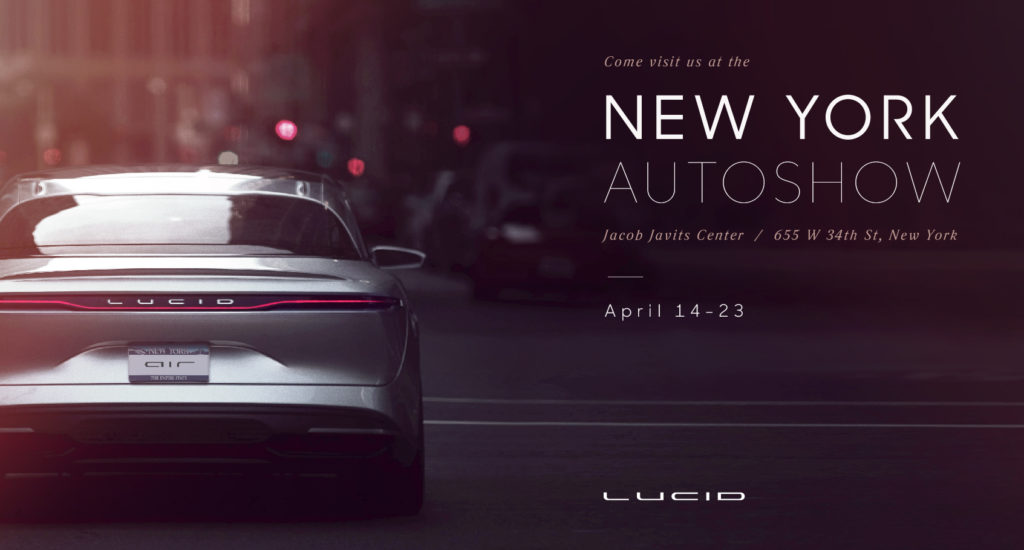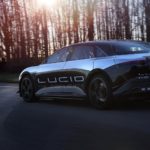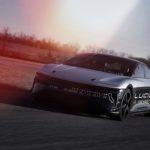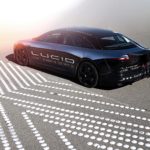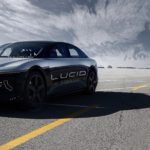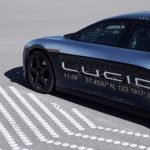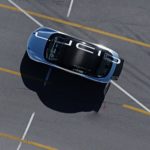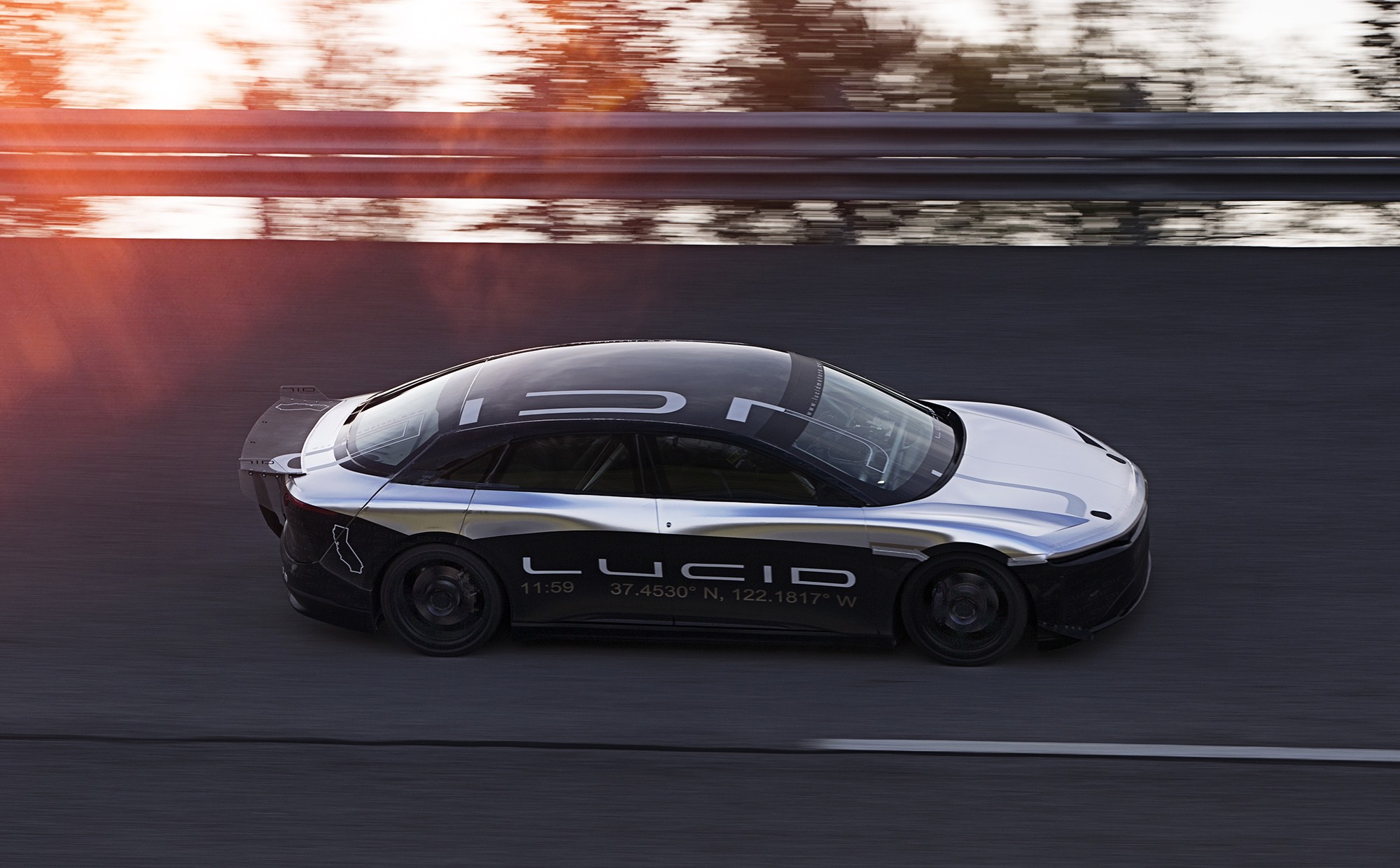
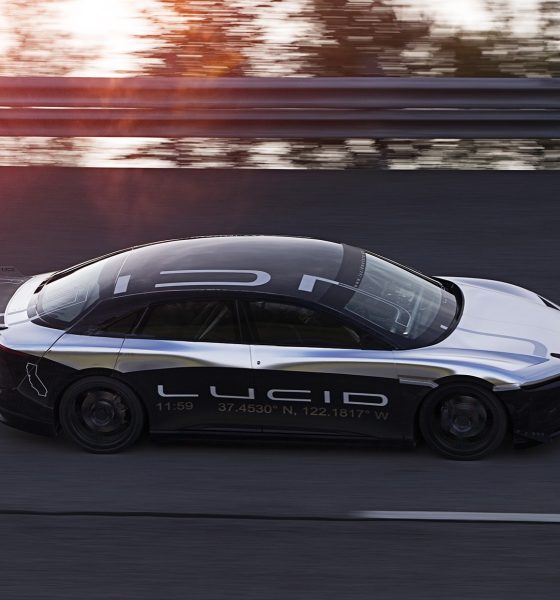
News
All-electric Lucid Motors ‘Air’ reaches 217 mph in high speed stability test
Making a grand entrance at the 117th-annual New York International Auto Show today is electric car startup Lucid Motors. The California-based maker of the “private jet on wheels” is debuting its ultra luxury Lucid ‘Air’ along with its Alpha Speed Car, which recently completed its first high-speed stability test at a software limited 217 mph (350km/h).
The fully autonomous capable Lucid Air represents a new take on luxury vehicles, packing in amenities often found in private jets and boasts expansive space with an exterior footprint of a mid-sized car. On paper, the Air may seem like a direct competitor with current Silicon Valley sweetheart, Tesla’s Model S. However, one can argue that the Lucid Air – with its Maybach quality interior and unprecedented performance – is better equipped to stand in a class of its own. The Air will ship with autonomous ready hardware, and when paired with the distinct focus on passenger comfort and luxury, the all electric powertrain that’s capable of 400 miles of range and 1,000 horsepower starts feeling like a different kind of experience altogether. Impressively, the luxury of the Air will start at just $52,500 after federal tax credits, which is a sizable savings from the costlier Tesla Model S.
ALSO SEE: Tesla Model S vs. Lucid Air: comparison of range, performance and price
Lucid Motors is raising capital to build out the first phase of manufacturing from its upcoming plant in Casa Grande, Arizona. The $700 million factory is expected to begin production on the Lucid Air in 2019 and produce 10,000 vehicles within the first 12 months. Lucid Motors revealed through today’s press release that the factory will reach full capacity in 2022 and produce 130,000 vehicles annually.
The company also announced through the press release that it has begun high speed testing of an Alpha prototype of the Air.
“In preparation for production, Lucid Air Alpha prototypes are undergoing a rigorous development program. Lucid has designated one of these test prototypes as a high-performance test vehicle and has installed a roll-cage for safety purposes. The Alpha Speed Car will be used for evaluating at-the-limit performance.”
Lucid completed the high speed stability on a 7.5 mile oval race track at the independent automotive testing ground TRC Ohio. The vehicle was able to successfully complete the stability and high speed testing at a staggering 217mph (350km/h).
Here are some amazing photos captured during the high speed run.
Unlike Tesla which produces lithium ion battery cells with partner Panasonic, Lucid has locked in an exclusive battery deal with Samsung SDI and will utilize “next-generation cylindrical cells that are able to exceed current performance benchmarks in areas such as energy density, power, calendar life and safety”, according to an announcement made by the company.
Results from Lucid’s 217 mph high speed testing would indicate that the company may have developed a sophisticated battery thermal management system that allows the battery pack to supply maximum output to the vehicle’s high efficiency motor. Lucid Motors Chief Technology Officer Peter Rawlinson has taken his years of experience, previously working at Tesla where he served as Chief Engineer, and rolled that into a battery management system that overcomes thermal limitations faced by Tesla’s system. The Electric GT all-Model S race team experienced some overheating issues after spending time on the racetrack with their Model S:
“The problem is the car has thermal limitations. You can have a very fast car on a qualifying lap, then it goes back to nominal power for 15 or 16 laps…If you save the temperature you can peak it again. The challenge will be to drive as quickly as possible without overheating the motor.”
Only time will tell if Lucid Motors can deliver on its grand vision of the future. If the test drive we took in Los Angeles is any indicator of what’s to come, Lucid Motors is on track to live up to its promises, tenfold.
Lucid Air Makes International Auto Show Debut in New York
Luxury electric sedan completes first high speed stability test at 217 mph
New York, NY, April 13, 2017 – Lucid Motors made its global auto show debut today at the 117th-annual New York International Auto Show. The company showed the Lucid Air luxury electric sedan and also presented its Alpha Speed Car test vehicle, which had just completed its first high-speed stability test at 217 mph.
Lucid Air: Leading the Charge in Luxury Mobility
The Lucid Air was first unveiled in December 2016. The all-electric sedan combines forward- looking design with groundbreaking technology to establish an entirely new class of vehicle. Featuring full-size interior space in a mid-size exterior footprint, the autonomous-ready Air will be available with up to 400 miles of range and 1,000 horsepower.
The Air will be manufactured in Casa Grande, Arizona. The factory, first announced in November 2016, will come online in 2019 and build 10,000 vehicles in the first 12 months. By 2022 the factory is expected to employ 2,000 full-time employees and manufacture up to 130,000 vehicles annually.
The Lucid Air is priced from $52,500 after federal tax credits. The base Lucid Air will feature a 400-horsepower motor, rear-wheel drive, and a 240-mile range. Deliveries will begin in 2019. Customers can pre-order the Air at https://lucidmotors.com/car/reserve.
High Speed Testing: Evaluating Stability and Durability at 217 mph
In preparation for production, Lucid Air Alpha prototypes are undergoing a rigorous development program. Lucid has designated one of these test prototypes as a high-performance test vehicle and has installed a roll-cage for safety purposes. The Alpha Speed Car will be used for evaluating at-the-limit performance.
For the Alpha Speed Car’s first testing session, Lucid headed to TRC Ohio to use their 7.5-mile oval to evaluate high-speed behaviors, including vehicle stability and powertrain thermal management. The test, software-limited to 217mph (350km/h), was successful in demonstrating the capabilities of the car and in finding areas for improvement that could not be properly evaluated in static bench tests.
Real-world tests are an important part of the engineering process, allowing the team to correlate computer simulation models with real-world performance. The collected data will now be used to finesse thermal and aero computer simulations and to make further performance improvements that will be tested later this year at higher speeds.
A video of the test can be seen at https://youtu.be/7k03MH7ztUs.

Elon Musk
Starlink passes 9 million active customers just weeks after hitting 8 million
The milestone highlights the accelerating growth of Starlink, which has now been adding over 20,000 new users per day.

SpaceX’s Starlink satellite internet service has continued its rapid global expansion, surpassing 9 million active customers just weeks after crossing the 8 million mark.
The milestone highlights the accelerating growth of Starlink, which has now been adding over 20,000 new users per day.
9 million customers
In a post on X, SpaceX stated that Starlink now serves over 9 million active users across 155 countries, territories, and markets. The company reached 8 million customers in early November, meaning it added roughly 1 million subscribers in under seven weeks, or about 21,275 new users on average per day.
“Starlink is connecting more than 9M active customers with high-speed internet across 155 countries, territories, and many other markets,” Starlink wrote in a post on its official X account. SpaceX President Gwynne Shotwell also celebrated the milestone on X. “A huge thank you to all of our customers and congrats to the Starlink team for such an incredible product,” she wrote.
That growth rate reflects both rising demand for broadband in underserved regions and Starlink’s expanding satellite constellation, which now includes more than 9,000 low-Earth-orbit satellites designed to deliver high-speed, low-latency internet worldwide.
Starlink’s momentum
Starlink’s momentum has been building up. SpaceX reported 4.6 million Starlink customers in December 2024, followed by 7 million by August 2025, and 8 million customers in November. Independent data also suggests Starlink usage is rising sharply, with Cloudflare reporting that global web traffic from Starlink users more than doubled in 2025, as noted in an Insider report.
Starlink’s momentum is increasingly tied to SpaceX’s broader financial outlook. Elon Musk has said the satellite network is “by far” the company’s largest revenue driver, and reports suggest SpaceX may be positioning itself for an initial public offering as soon as next year, with valuations estimated as high as $1.5 trillion. Musk has also suggested in the past that Starlink could have its own IPO in the future.
News
NVIDIA Director of Robotics: Tesla FSD v14 is the first AI to pass the “Physical Turing Test”
After testing FSD v14, Fan stated that his experience with FSD felt magical at first, but it soon started to feel like a routine.

NVIDIA Director of Robotics Jim Fan has praised Tesla’s Full Self-Driving (Supervised) v14 as the first AI to pass what he described as a “Physical Turing Test.”
After testing FSD v14, Fan stated that his experience with FSD felt magical at first, but it soon started to feel like a routine. And just like smartphones today, removing it now would “actively hurt.”
Jim Fan’s hands-on FSD v14 impressions
Fan, a leading researcher in embodied AI who is currently solving Physical AI at NVIDIA and spearheading the company’s Project GR00T initiative, noted that he actually was late to the Tesla game. He was, however, one of the first to try out FSD v14.
“I was very late to own a Tesla but among the earliest to try out FSD v14. It’s perhaps the first time I experience an AI that passes the Physical Turing Test: after a long day at work, you press a button, lay back, and couldn’t tell if a neural net or a human drove you home,” Fan wrote in a post on X.
Fan added: “Despite knowing exactly how robot learning works, I still find it magical watching the steering wheel turn by itself. First it feels surreal, next it becomes routine. Then, like the smartphone, taking it away actively hurts. This is how humanity gets rewired and glued to god-like technologies.”
The Physical Turing Test
The original Turing Test was conceived by Alan Turing in 1950, and it was aimed at determining if a machine could exhibit behavior that is equivalent to or indistinguishable from a human. By focusing on text-based conversations, the original Turing Test set a high bar for natural language processing and machine learning.
This test has been passed by today’s large language models. However, the capability to converse in a humanlike manner is a completely different challenge from performing real-world problem-solving or physical interactions. Thus, Fan introduced the Physical Turing Test, which challenges AI systems to demonstrate intelligence through physical actions.
Based on Fan’s comments, Tesla has demonstrated these intelligent physical actions with FSD v14. Elon Musk agreed with the NVIDIA executive, stating in a post on X that with FSD v14, “you can sense the sentience maturing.” Musk also praised Tesla AI, calling it the best “real-world AI” today.
News
Tesla AI team burns the Christmas midnight oil by releasing FSD v14.2.2.1
The update was released just a day after FSD v14.2.2 started rolling out to customers.

Tesla is burning the midnight oil this Christmas, with the Tesla AI team quietly rolling out Full Self-Driving (Supervised) v14.2.2.1 just a day after FSD v14.2.2 started rolling out to customers.
Tesla owner shares insights on FSD v14.2.2.1
Longtime Tesla owner and FSD tester @BLKMDL3 shared some insights following several drives with FSD v14.2.2.1 in rainy Los Angeles conditions with standing water and faded lane lines. He reported zero steering hesitation or stutter, confident lane changes, and maneuvers executed with precision that evoked the performance of Tesla’s driverless Robotaxis in Austin.
Parking performance impressed, with most spots nailed perfectly, including tight, sharp turns, in single attempts without shaky steering. One minor offset happened only due to another vehicle that was parked over the line, which FSD accommodated by a few extra inches. In rain that typically erases road markings, FSD visualized lanes and turn lines better than humans, positioning itself flawlessly when entering new streets as well.
“Took it up a dark, wet, and twisty canyon road up and down the hill tonight and it went very well as to be expected. Stayed centered in the lane, kept speed well and gives a confidence inspiring steering feel where it handles these curvy roads better than the majority of human drivers,” the Tesla owner wrote in a post on X.
Tesla’s FSD v14.2.2 update
Just a day before FSD v14.2.2.1’s release, Tesla rolled out FSD v14.2.2, which was focused on smoother real-world performance, better obstacle awareness, and precise end-of-trip routing. According to the update’s release notes, FSD v14.2.2 upgrades the vision encoder neural network with higher resolution features, enhancing detection of emergency vehicles, road obstacles, and human gestures.
New Arrival Options also allowed users to select preferred drop-off styles, such as Parking Lot, Street, Driveway, Parking Garage, or Curbside, with the navigation pin automatically adjusting to the ideal spot. Other refinements include pulling over for emergency vehicles, real-time vision-based detours for blocked roads, improved gate and debris handling, and Speed Profiles for customized driving styles.
